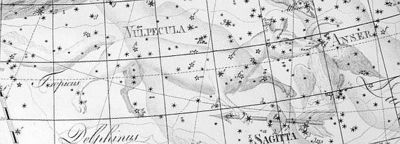Vulpecula
| Constellation | |
List of stars in Vulpecula |
|
| Abbreviation | Vul |
|---|---|
| Genitive | Vulpeculae |
| Pronunciation | pronounced /vʌlˈpɛkjʊlə/, genitive /vʌlˈpɛkjʊliː/ |
| Symbolism | the Fox |
| Right ascension | 20 h |
| Declination | +25° |
| Quadrant | NQ4 |
| Area | 268 sq. deg. (55th) |
| Main stars | 5, 20 |
| Bayer/Flamsteed stars |
33 |
| Stars with planets | 3 |
| Stars brighter than 3.00m | 0 |
| Stars within 10.00 pc (32.62 ly) | 0 |
| Brightest star | α Vul (Anser) (4.44m) |
| Nearest star | Ross 165 (33.54 ly, 10.28 pc) |
| Messier objects | 1 |
| Bordering constellations |
Cygnus Lyra Hercules Sagitta Delphinus Pegasus |
| Visible at latitudes between +90° and −55°. Best visible at 21:00 (9 p.m.) during the month of September. |
|
Vulpecula is a faint constellation in the northern sky. Its name is Latin for "little fox", although it is commonly known simply as the fox. It was created in the seventeenth century, and is located in the middle of the Summer Triangle (an asterism consisting of the bright stars Deneb, Vega and Altair).
Contents |
Notable features
Stars
There are no stars brighter than 4th magnitude in this constellation. The brightest star in Vulpecula is α Vulpeculae, a magnitude 4.44m red giant at a distance of 297 light-years. The star is an optical binary (separation of 413.7") that can be split using binoculars. The star also carries the traditional name Anser, which refers to the goose the little fox holds in its jaws.
In 1967, the first pulsar, PSR B1919+21, was discovered in Vulpecula by Antony Hewish and Jocelyn Bell, in Cambridge. While they were searching for scintillation of radio signals of quasars, they observed pulses which repeated with a period of 1.3373 seconds.[1] Terrestrial origin of the signal was ruled out because the time it took the object to reappear was a sidereal day instead of a solar day. This anomaly was finally identified as the signal of a rapidly rotating neutron star. Fifteen years after the first pulsar was discovered, the first millisecond pulsar, PSR B1937+21, was also discovered in Vulpecula, only a few degrees in the sky away from PSR B1919+21.[2]
Vulpecula is also home to HD 189733 b, the closest extrasolar planet currently being studied by the Spitzer Space Telescope. On 12 July 2007 the Financial Times (London) reported that the chemical signature of water vapour was detected in the atmosphere of this planet. Although HD 189733b with atmospheric temperatures rising above 1 000 °C is far from being habitable, this finding increases the likelihood that water, an essential component of life, would be found on a more Earth-like planet in the future.
Deep sky objects
Two well-known deep sky objects can be found in Vulpecula. The Dumbbell Nebula (M27), is a large, bright planetary nebula which was discovered by the French astronomer Charles Messier in 1764 as the very first object of its kind. It can be seen with good binoculars in a dark sky location, appearing as a dimly glowing disk approximately 6 arcminutes in diameter. A telescope reveals its double-lobed shape, similar to that of an hourglass. Brocchi's Cluster (Collinder 399) is an asterism formerly thought to be an open cluster. It is also called "the Coathanger" because of its distinctive star pattern when viewed with binoculars or a low power telescope.
History

In the late 17th century, the astronomer Johannes Hevelius created Vulpecula. It was originally known as Vulpecula cum ansere ("the little fox with the goose" or Vulpecula et Anser ("the little fox and the goose"), and was illustrated with a goose in the jaws of a fox. Hevelius did not regard the fox and the goose to be two separate constellations, but later the stars were divided into a separate Anser and Vulpecula. Today, they have been merged again under the name of the fox, but the goose is remembered by the name of the star α Vulpeculae: Anser.
References
- ↑ Hewish, A.; Bell, S. J.; Pilkington, J. D. H.; Scott, P. F.; Collins, R. A. (1968). "Observation of a Rapidly Pulsating Radio Source". Nature 217: 709–713. doi:10.1038/217709a0. http://www.nature.com/nature/journal/v217/n5130/abs/217709a0.html. Retrieved 2007-07-06.
- ↑ D. Backer et al. (1982). "A millisecond pulsar". Nature 300: 315–318. doi:10.1038/300615a0. http://www.nature.com/nature/journal/v300/n5893/abs/300615a0.html.
- Ian Ridpath and Wil Tirion (2007). Stars and Planets Guide, Collins, London. ISBN 978-0007251209. Princeton University Press, Princeton. ISBN 978-0691135564.
External links
- The Deep Photographic Guide to the Constellations: Vulpecula
- Vulpecula page at SEDS (Students for the Exploration and Development of Space)
- M-27 page at SEDS
- Star Tales - Vulpecula
|
|||||
|
||||||||||||||||||||||||||||||||